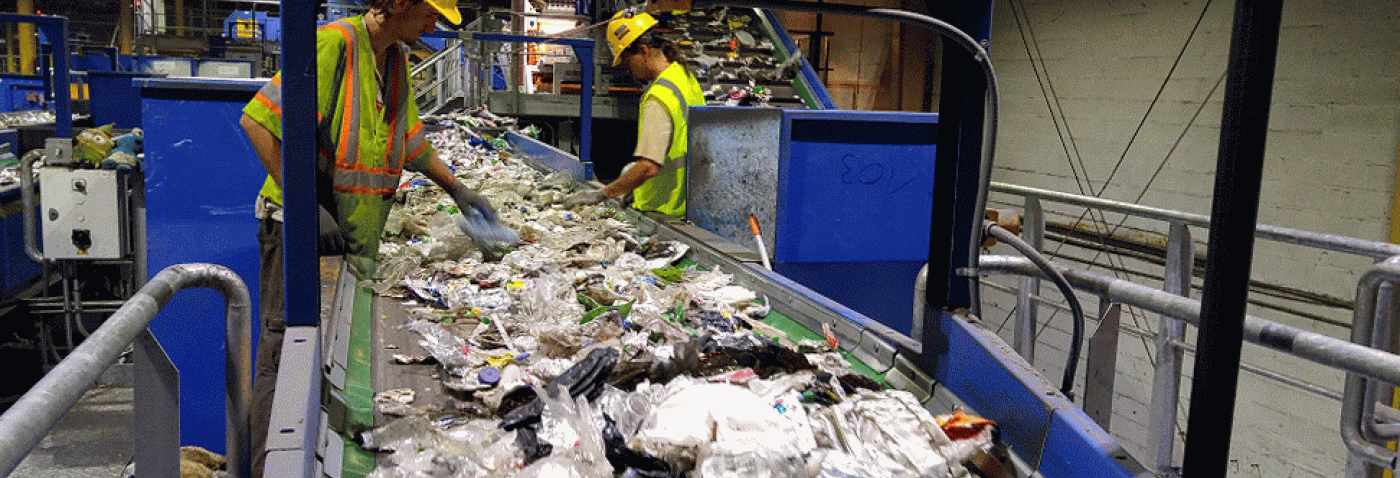College of Liberal Arts & Sciences

Where Does My Recycling Go?
Have you ever wondered what happens to your recyclables after you place them in the recycling container? Well, there are a number of steps that have to take place in order to turn your old soda can into a new soda can.
1. You Recycle
Every time you place an item in the recycling bin, you are helping to keep valuable commodities out of the landfill, while also conserving natural resources used to make new products. Be sure to recycle everything you can using the University's easy single-stream system. Single-stream recycling means you can put all recyclables (e.g., paper, cardboard, plastic containers, metal containers) all in one bin, no sorting necessary.
2. UI Custodial Staff Collects Recyclables
University of Iowa custodians empty recyclables from communal containers and take the materials to the exterior recycling dumpster or cart to await collection.
3. Waste Management Hauls Recyclables

Waste Management has a fleet of trucks that drive around campus collecting all of the recyclables that have been placed in the exterior recycling dumpsters and carts. Once a truck is full, it takes the recyclables to a Materials Recovery Facility (MRF) in Cedar Rapids.
4. Everything Gets Sorted

Once at the MRF, a combination of automated machinery and manual laborers sort through the mixed recyclables and separate materials into different categories. Non-recyclable items (aka, contaminants), are removed during the sorting process, however, they can cause problems at the MRF, so it's important to minimize contamination by recycling right.
The recyclables are dumped as a mixture onto the tipping floor and fed onto an inclined conveyor belt. As the materials proceed, ferrous metals such as soup cans are pulled out by a magnet. Aluminum is non-ferrous but does react to the electrical charge of a spinning magnet called an eddy current. When the aluminum comes into contact with the eddy current, the aluminum literally jumps off the conveyor belt into a collection bin!
 Paper, cardboard, and plastic drop onto a separate conveyor for further separation. Line workers pull paper and cardboard off of the conveyor and toss them down shutes inot separate collection bins. Then, plastics are either separated manually by resin type (which is indicated by the number inside the recycling arrows) or by special machinery.
Paper, cardboard, and plastic drop onto a separate conveyor for further separation. Line workers pull paper and cardboard off of the conveyor and toss them down shutes inot separate collection bins. Then, plastics are either separated manually by resin type (which is indicated by the number inside the recycling arrows) or by special machinery.
Once separated, the materials are baled (or loaded into a large container) and sent on to be reprocessed into new products.
5. Manufacturers Buy Recyclables And Turn Them Into New Products
 Many businesses manufacture new products from recycled materials and they rely on you to provide the recyclables that keep their plants running. Each type of material is processed differently based on its unique characteristics. For example, plastic is shredded, cleaned, and shaped into pellets that are remelted into a variety of new plastic products. Aluminum and steel are shredded, cleaned, and melted into new aluminum and steel products. Paper and cardboard are recycled by mixing them with water to create a pulp slurry in a giant blender called a pulper. The pulp mix passes through cleaning equipment to remove any contaminants. Next, the pulp goes through an ink removal process and then is spread out over large screens and dried to become new paper and cardboard.
Many businesses manufacture new products from recycled materials and they rely on you to provide the recyclables that keep their plants running. Each type of material is processed differently based on its unique characteristics. For example, plastic is shredded, cleaned, and shaped into pellets that are remelted into a variety of new plastic products. Aluminum and steel are shredded, cleaned, and melted into new aluminum and steel products. Paper and cardboard are recycled by mixing them with water to create a pulp slurry in a giant blender called a pulper. The pulp mix passes through cleaning equipment to remove any contaminants. Next, the pulp goes through an ink removal process and then is spread out over large screens and dried to become new paper and cardboard.
6. Consumers Buy Recycled Products
 The final step is buying products made from post-consumer recycled materials. When you buy post-consumer recycled products, you create a demand for those products and strengthen the markets for the items you put in your recycling bin. After all, if no one buys recycled products, there's not reason to recycle in the first place.
The final step is buying products made from post-consumer recycled materials. When you buy post-consumer recycled products, you create a demand for those products and strengthen the markets for the items you put in your recycling bin. After all, if no one buys recycled products, there's not reason to recycle in the first place.